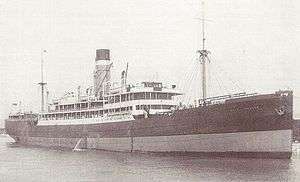SS City of Venice
 | |
| History | |
|---|---|
| Name: | City of Venice |
| Operator: | Ellerman Lines Ltd, London |
| Port of registry: |
|
| Builder: | Workman, Clark & Co Ltd, Belfast |
| Completed: | 1924 |
| Identification: | UK official number 147890 |
| Fate: | sunk on 4 July 1943 |
| General characteristics | |
| Class and type: | passenger steamship |
| Tonnage: | |
| Length: | 455.2 ft (138.7 m) |
| Beam: | 58.1 ft (17.7 m) |
| Draught: | 34 ft 0 in (10.36 m) |
| Depth: | 31.3 ft (9.5 m) |
| Decks: | 2 |
| Installed power: | 972 NHP |
| Propulsion: | quadruple-expansion steam engine |
| Crew: | 158 |
The SS City of Venice was a British passenger steamship that was sunk in the Second World War. She was built by Workman, Clark & Co Ltd, Belfast for Ellerman Lines Ltd, of London in 1924. She was registered in Glasgow.
Wartime career and sinking
The City of Venice was used for numerous duties in the Second World War, including service as a troop transport. Her final duty was to take part in Operation Husky, the Allied invasion of Sicily in 1943. Under the command of her Master, James Wyper, she was part of the military convoy KMS-18B, carrying 292 troops of the 1st Canadian Infantry Division and 700 tons of military equipment. She left the Firth of Clyde on 24 June bound for Algiers.
At 2140 hours on 4 July the convoy was sighted and attacked by U-409 commanded by Kapitanleutnant Hanns Ferdinand Massmann. U-boat fired a spread of four torpedoes at the convoy, by now 10 miles north of Cape Tenez, Algeria. She then reported the sinking of a freighter, but had in fact hit and sunk two ships, St. Essylt and City of Venice.
The master, ten crew members and ten troops were those who died in the sinking, while 147 crew members, 22 gunners, 282 troops and ten naval personnel were rescued by the Flower-class corvettes HMS Honeysuckle and HMS Rhododendron, the River-class frigate HMS Teviot and the rescue tug Restive. The survivors were then landed at Algiers.
U-409 was sunk on 7/12/1943 in the Mediterranean by the destroyer HMS Inconstant by depth chargers. Most of the crew survived.
References
Coordinates: 36°44′N 1°31′E / 36.733°N 1.517°E